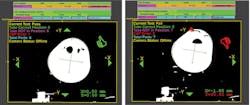Industrial Automation: Smart cameras speed automated automobile assembly
Developers of automated automobile assembly systems must ensure that, to increase productivity and lower manufacturing costs, down-time must be kept to a minimum. Not doing so can result in increased cost that must then be passed on to the consumer.
In the manufacture of F-150 trucks, Ford Motor Company needed to ensure that the fuel filler system mounted to the bed of the truck was properly mounted. This task is complicated since four different frame lengths (ranging from 122in to 163in) need to be accommodated. If the fuel filler is not correctly placed, then the bed of the truck will not fit onto the frame properly. Indeed, if the tube is not in the correct position before the bed is decked to the vehicle, it will be damaged. This causes significant downtime because the vehicle then needs to be removed from the production line or the part repaired.
The issue was not identified until the launch of the new F-150 in 2014, as the previous model did not have the same assembly challenges. "Down-time is not an option since costs can exceed over $10,000 per minute." says Brian VanderPryt, Manager of the Vision Systems and Special Projects Group at Indicon Corp. (Sterling Heights, MI, USA; www.indicon.com), a Tier-One supplier to automotive companies.
To overcome this, several solutions were attempted including using a special clamp to hold the tube in position and installing a rounded cap on the fuel-fill neck prior to decking to help to guide the fuel filler into the box. "While useful, these mechanical solutions were not enough to guarantee that the bed and frame could be perfectly docked 100% of the time," says VanderPryt.
To accomplish this, VanderPryt and his colleagues at Indicon Corp developed a machine vision system based on smart cameras and off-the shelf lighting. To locate the cap 100% of the time, it was necessary to evenly illuminate the 4ft area of the truck frame (Figure 3a). This was accomplished using eight linear SVL L300-WHI white LED lights from Smart Vision Lights (SVL; Muskegon, MI, USA; www.smartvisionlights.com) mounted as two banks of four at 45° above the frame (Figure 3b).
To ensure that the vision system employed could locate the cap, a green color was chosen so that it could be more accurately determined using four In-Sight Micro 1400C cameras from Cognex (Natick, MA, USA; www.cognex.com). Based on the build data for each truck being produced, the correct camera was then triggered.
Since the system needs to verify that the cap is in location in 2D space, all of the cameras were first calibrated using a calibration grid to return real-world coordinate data. To consistently locate and inspect the part, a filter is applied to each captured image to highlight the green filler cap. To check whether the cap is in the correct position, blob analysis and pattern matching is used to determine the center of mass of the rounded green cap and this is compared with a master position (Figure 4a and 4b).
The system is then able to confirm that the cap is present and the fuel-filler tube is positioned within tolerance before the unit is indexed into the next station, where the cab and box are loaded on to the frame. "By installing the vision inspection system, the return on investment for the manufacturer was almost immediate since the down-time cost of a single crash would cost the same as the system itself," says VanderPryt.


